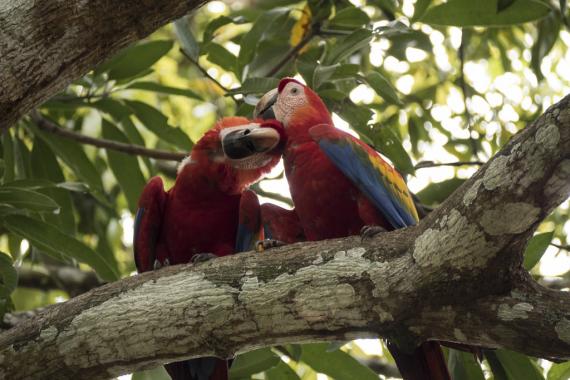Guarding Guaras
Current initiative
Published

Pair of scarlet macaws. ("CostaRica_20161113_118" by QuiRag is licensed under CC BY-NC 2.0)
Guara, or scarlet macaw, populations have fallen drastically across Central America as poachers steal the chicks to sell on to wealthy foreigners overseas. In 2015, One Earth Conservation incentivised local villagers in Mabita, Honduras, to protect the nests of guaras by offering them a cash payment. The project has resulted in increased numbers in the region, created a cash economy in Mabita and instilled a sense of stewardship amongst local villagers. The project area is now the largest community-patrolled parrot conservation area in Latin America.
Lead

Location
The project started in Mabita, which is a hamlet four hours’ drive from the coast in Honduras, but has now spread to other communities.
The poaching and wildlife trade problem
Species affected Scarlet Macaw Ara macao
Products in tradeLive chicks and eggs for the international pet trade.
Overview of the problem
Poachers climb the pine trees where guaras nest and steal the chicks before they are able to fly. The birds fetch up to $6,000 online and in 2014 no guara chicks reached adulthood in their native habitat.
The anti-IWT initiative
In 2010, One Earth Conservation enlisted the residents of Mabita to patrol the forest. Over the years, they built trust and engaged the local communities and in 2015 launched paid community patrols to monitor and protect nests. They also established a rescue centre for confiscated birds.
The strategy
Strengthening disincentives for illegal behaviour
Villagers are paid 200 lempiras ($8) a day to patrol the forests.
Has the initiative made a difference?
The birds have increased in numbers and in 2018, 103 nests were left undisturbed in the area with about 150 guara chicks surviving. Money made from patrolling has created a cash economy in Mabita and inhabitants have used it to build a small stone church. A further five villages have since joined the scheme and communities receive great pleasure from watching the birds.
What works and why
The income provided to communities to conserve the guaras, rather than poach them, has been a key factor in changing the trend, as well as the trust built in protecting an iconic species for the community.
Factors for success
Transparent and accountable distribution of benefits to local communities
Clear and tangible benefits to local communities from wildlife (These may be financial and/or non-financial)
Organisers, donors and partners
United States Fish and Wildlife Service
For further information contact (peoplenotpoaching@gmail.com).